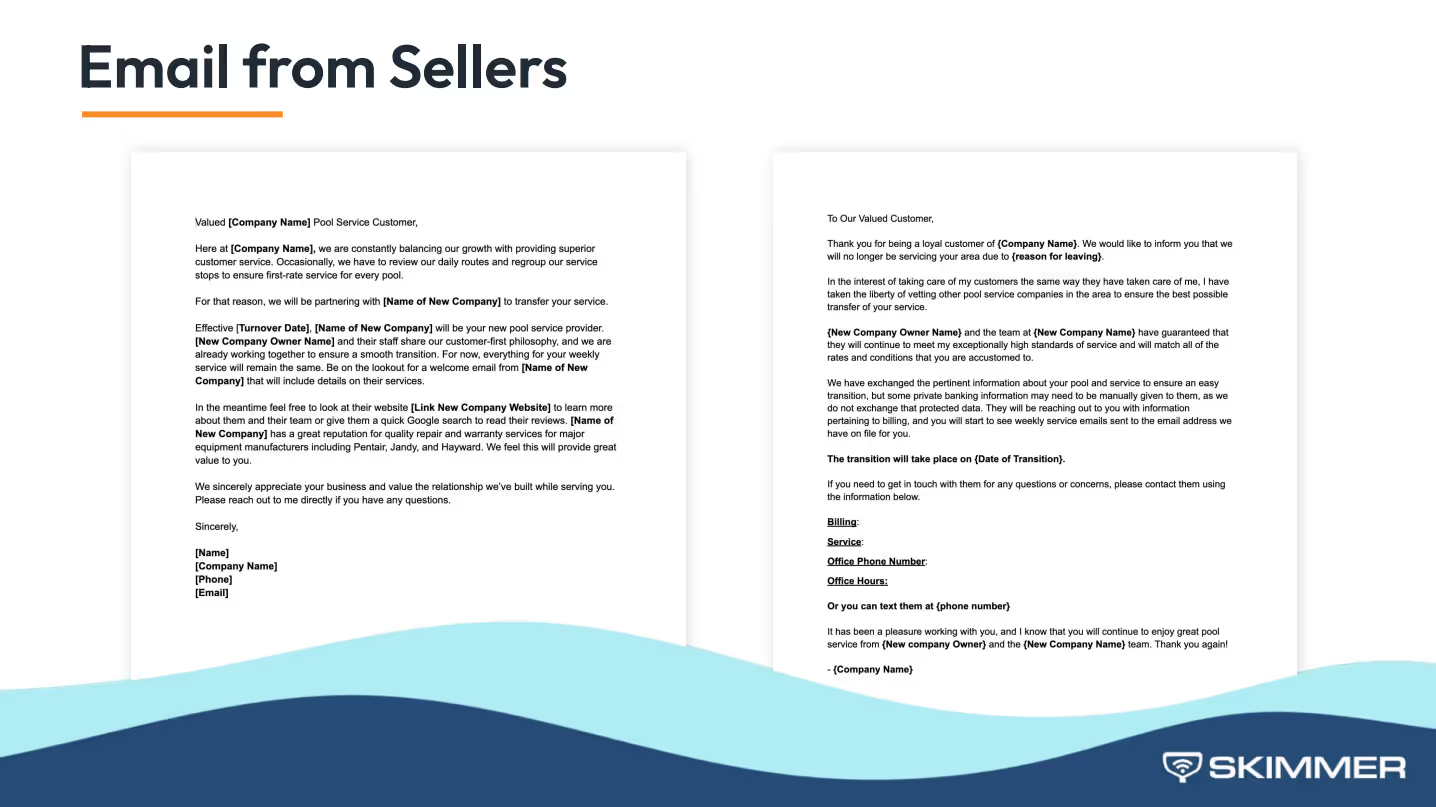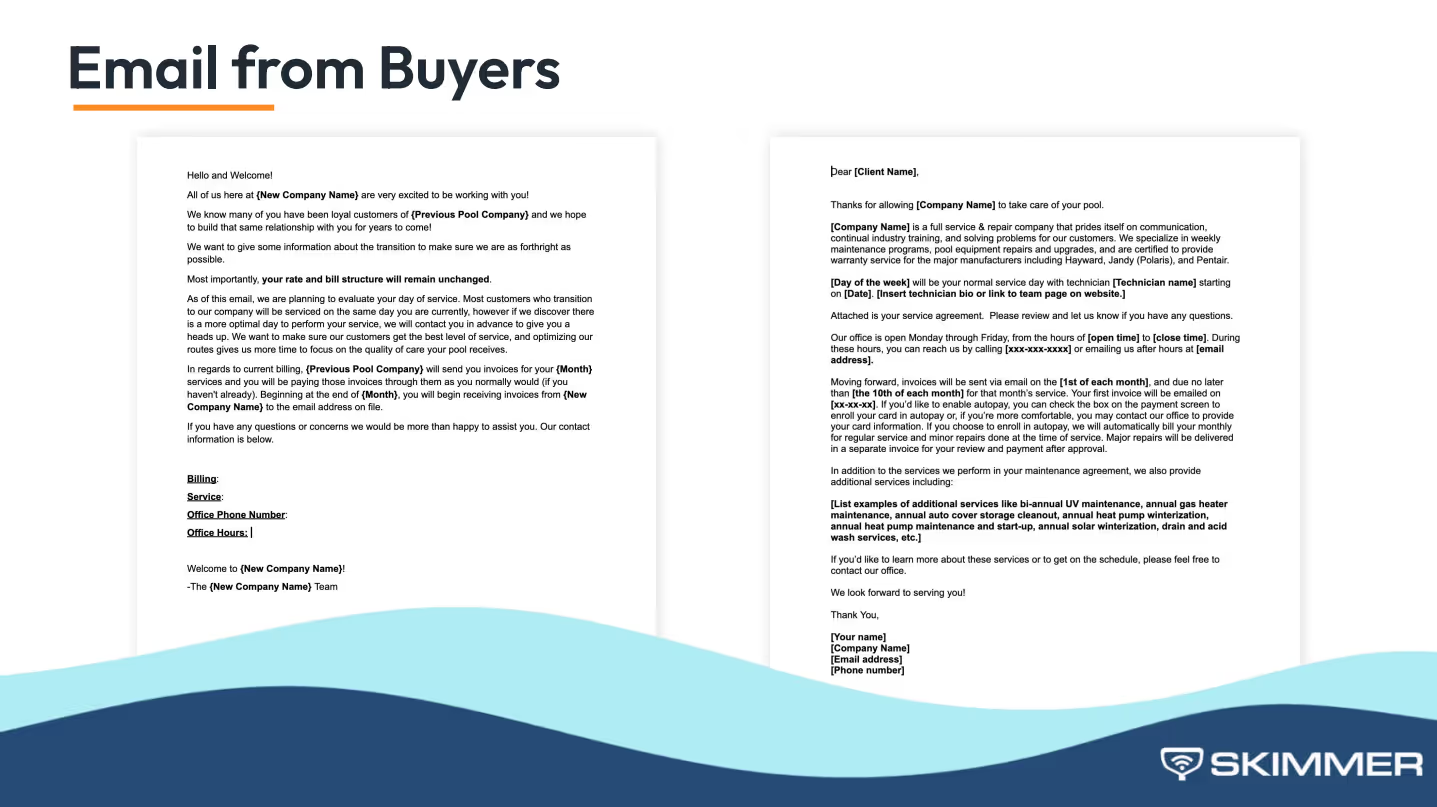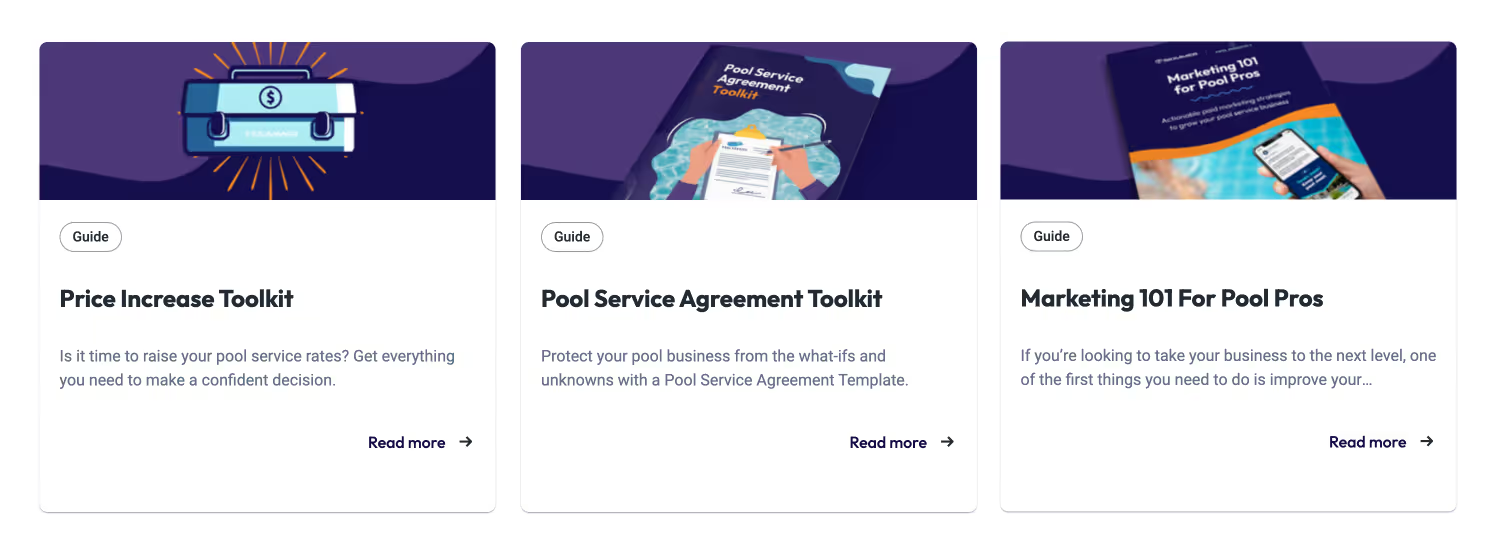.avif)
Key takeaways:
- Buying/selling pool routes: treat as a business acquisition, not real estate.
- Routes are mainly goodwill, not equipment.
- Financing options include SBA, home equity, seller financing, or a broker for first-timers.
- Valuation depends on local multiples (6–12 months revenue), customer data, geography, and pool condition; use Skimmer’s ROI calculator.
- Secure the deal with solid contracts: itemize pools, customer data, guarantees, non-competes, and transition plans.
- Conduct due diligence—inspect pools for issues. After closing, ensure a smooth handoff: communicate with customers, align billing, introduce your team, and carefully plan rate changes (ideally after six months).
- Skimmer supports acquisitions with tools like price-increase calculators, marketing guides, and a peer forum.
This blog post is a summary of a Skimmer webinar from September 2024 with Kyle Peter, owner of Nevergreen Pools, and Tom Walsh, owner of Integrity Pool Service. Click here to watch the full webinar on demand.
Buying and selling pool routes is a big part of what keeps the pool service industry moving. Many veteran pool service owners use it as a growth strategy, but for those who are early on in their growth journey, it can be daunting.
The plus side of acquiring pools is that it ensures fast growth—you can go from zero to 50 pools overnight. The other side of that coin, of course, is that you could easily bite off more than you can chew if you’re not strategic about it.
To explain the ins and outs of buying and selling pool routes, we sat down with two experts in the space:
- Kyle Peter: Owner of Nevergreen Pools
- Tom Walsh: Owner of Integrity Pool Service

While Kyle has used acquisitions to gain a third of Nevergeen’s 1,000 customers over the last six years, Tom has both bought and sold pool routes over the same time period to optimize his roster of 400 customers.
During this webinar, our hosts answered many common questions first-time pool route buyers (or sellers) may have—from how to finance an acquisition to what goes into a contract to transition strategies that keep customers satisfied.
Let’s go through each consideration step by step.
Approaches to buying and selling pool routes
As Kyle pointed out at the top of the webinar, buying and selling pool routes is just like buying and selling real estate—except that it isn’t, really. As he put it, “There’s a lot of activity in the investment and growth world of acquiring businesses, but there are some caveats to be aware of with pool routes.”
For example, it’s important to remember that, with pool routes, you’re not buying anything tangible. Goodwill is the main asset, which is essentially a customer list and an agreement with the seller to transition these customers to your services.
Since you’re not purchasing collateral in a pool route sale, getting a traditional loan is difficult. But there are options:
- Small Business Administration (SBA) loans are possible but not always ideal due to the absence of collateral.
- Home equity lines—where the buyer puts their home up as collateral—are generally recommended by brokers. Of course, given the risk associated with this method, it’s ultimately a personal decision for the buyer to make.
- Other financing options are seller financing—which is essentially a loan from the seller—or leasing, where the buyer works on the new pool route while the seller continues to collect a portion of the income until a certain amount of revenue is reached.
Brokers are a great option for first-time buyers
Going through a broker is the best financing option for many first-time pool route buyers. As Tom remembers, “I wouldn’t have bought my first route if I hadn’t gone through a broker. It gave me the confidence to know that I wasn’t just throwing my money away.”
These days, Tom has enough experience to know that most customers are just happy to have someone take over their service, but he still talks to a lot of people who share that same fear he had early on. “They say, ‘I’m not buying anything tangible; what’s preventing these customers from canceling tomorrow?’” Going through a broker can add a level of security that makes it easier to get over that fear.
If you do decide to go through a broker, you should expect the following:
- Brokers typically charge you 12x the monthly service revenue of the pools you’re acquiring
- Repair revenue is not guaranteed and, therefore, not factored into the sale
- A broker can handle legal paperwork, guarantees, and replacement accounts
- Brokers can also provide structure to the transition and hold funds in escrow
- Ultimately, brokers serve as a neutral third party that helps “keep friends, friends”
- Licensed brokers have a fiduciary duty and a duty of confidentiality, which can provide a level of security
A brokered transaction tends to look something like this:

Where do people buy and sell pool routes?
If you want to buy a pool route, you need to know where to look for one. Tom and Kyle have their own methods that have worked well for each of them.
Tom Walsh: “I have posted and bought off of Craigslist, Facebook Marketplace, and through general networking to local people I know. Most supply houses have a bulletin board where people sometimes post routes as well.”
Kyle Peter: “Our approach has been to be open with the community and share that we’re looking to grow through acquisition. We also share the typical multiples we pay. Most deals come about through people knowing that we’re interested in growing through acquisition.”
What is a pool route worth? How to navigate valuation
Buying a pool route through a broker typically follows a pretty standard valuation process. As Kyle explains, “If a route in our area is going to be sold through a broker, the seller is going to get 10 months [of revenue], and the buyer pays 12 months (the broker keeps two months).”

Without a broker, it’s less straightforward. At Nevergreen, “10 months is the max we need to offer,” says Kyle. “In our area, offering less than six months is not really seen as a serious offer.” What his team offers within that six to 10-month range depends on a number of factors the buyer should be asking themself:
- Geographic location: Is the route located in an area that’s tightly populated with other pools we’re already servicing, meaning there’s no added cost to get there?
- Type/condition of pools or spas: Are the pools in good shape, with newer equipment?
- Potential repair and maintenance revenue: The flip side of acquiring newer pools in good shape is that there is less potential for repair revenue.
- Rate & rate type: Does the current service rate for these pools make sense? What’s included? What’s not included? For example, maybe these customers are used to getting filter cleanings included and no extra chemical cost or free service calls.
- Will techs be given an opportunity to transition? Are there employees who would be interested in being re-hired to work for you?
- Credit cards and email addresses on file: Are the customers used to being on autopay and paying with their credit cards? Does the seller have email addresses for all their customers? “If not, that’s game over for us,” says Kyle. “Especially considering that what we’re really buying is a list of customers.”
- Customer communication: How are the customers used to communicating with the company that was servicing them? Does it align with how you communicate?
Any or all of these factors could impact what a buyer is willing to pay for a route, so make sure your assessment is thorough and takes each of them into account.
Calculating ROI
Potential ROI is another important factor to consider before you go through with a pool route sale. Kyle suggests using Skimmer’s customer acquisition ROI calculator, which allows you to input all costs and pool stops to see your potential profit for each pool.
“Having a system that lets you do this is ideal,” says Kyle. “At Nevergreen, we look at our gross profit as everything after labor, chems, and materials are paid. Then we have our overhead costs and net profit.” Each of these calculations is important. For example, “Our overhead cost increases if we’re buying pools outside our neighborhood,” says Kyle, so that calculation should never be neglected.
Even before you analyze your ROI, says Kyle, “You have to know your numbers.” He prefers to look at guaranteed monthly residual income outside of repair revenue. “If you’re starting off with no idea how the pool industry works,” he says, “You can still do this by going through a broker.” You can also negotiate a month of training with the seller and understand how pool service works. “For that,” says Kyle, “Your profit margin should be high because you have no labor cost.”
But there’s more to ROI than what’s on paper. Tom reminds us that sometimes, it makes sense to buy pool routes that are priced below market, knowing you won’t be able to do a price increase for a while. For example, if they fit his current route, he’ll do it. “Florida’s the king of the gated community,” he says. “If I already have 30 [pools] in a community, I’ll take 10 more that are underpriced.”
Kyle adds, “I love taking control of my investments. Buying pools is an investment you have control over. I can give people a really good service that I’m in charge of.” Overall, you’re trying to analyze whether this route would be a good fit, which is much more than a numbers game.
Contracts and agreements: How to structure the deals
Once you’ve determined that a pool route is a good fit and can offer a decent ROI, it’s time to draw up a contract. Contracts sound scary, but as Kyle says, they’re really just an opportunity to write down the game plan on paper. Having said that, “Especially for your first acquisition, I would highly recommend you consult an attorney.”
More than anything, if you’re entering into a contract with anyone, “It’s really important to trust and have a good relationship with the party you’re selling or buying from,” says Kyle, “Especially if you’re not using a broker.”
What to include in your agreement
At a high level, your contracts and agreements should include:
- A purchase contract and/or bill of sale (equipment/trucks can either be included or handled separately)
- A list of accounts with all required data, such as Name, Address, Email Addresses, and Rate
- Who will be doing repairs after the transition
- A non-solicitation or non-compete agreement/clause
- A list of customers, each with their own value that is a multiple of that specific pool
- The time period of the agreement, which is usually five years.
- The following guarantees:some text
- Period of guarantee
- Terms of guarantee
- Terms for replacement accounts (this is optional but recommended)

The guarantee period in particular, is why you want to be paying per-pool as a multiple. As Kyle explains, “[At Nevergreen,] we set up a three-month guarantee where if the customer quits or doesn’t pay, we’ll get reimbursed for that pool, either with money or with another pool. We also usually withhold some of the payment to use it as the guarantee at the end of that period.” Knowing the value of each pool allows you to sort this out quickly if you encounter problems with any pools during the guarantee period.
Ultimately, the list of details in the agreement is a written outline of what you’re buying. Having a detailed agreement prevents the seller from turning around after the sale and marketing those same pools to someone else.
Do your due diligence
Having a detailed agreement is great, but it still doesn’t prevent everything from going sideways. Both Kyle and Tom suggest that the buyer does their own due diligence to make sure the deal makes sense for their business.
This includes making it a priority to see all the pools to make sure they exist and are in decent shape. “I’ve turned down routes where the routes weren’t up to par,” says Kyle. “We once went out with someone who was looking to sell their route of 50-80 pools, and after the first day, most of the pools had black algae. We wouldn’t have been able to deal with that from a chemicals and safety point of view.”
As a final bit of advice, both Kyle and Tom suggest that if you’re the buying party, you should purchase your route from someone who’s either retiring or leaving the business. In other words, look for a seller who is looking to pass on their legacy and is less likely to pass along:
- Bad pools
- Bad customers
- Late payers
- Locations on the outskirts of town
After the acquisition: What comes next
Buying a route is a huge undertaking, but it’s also just the beginning of your acquisition growth journey. Once you’ve acquired your customers, it’s important to stick the landing with a smooth transition that minimizes attrition.
Transition strategies: How to do a warm handoff
In the world of buying and selling pool routes, both parties have an incentive to ensure a smooth transition. The guarantee period is a sensitive time for all parties, and a warm handoff helps customers feel taken care of.
This time also presents a great opportunity for the buyer to set expectations and shine. At the start of the transition period, Nevergreen sends out an email to all customers they take over service for. In this email, they communicate:
- The date of transition
- Communication methods and preferences (setting expectations around email, text, or phone calls)
- Billing expectations: they prepare customers to receive a bill from a different vendor that might have a different payment method attached to it
- New tech/new team introductions
- Service days
- Service agreement with policies and expectations
- Value-added services that the previous provider might not have offered
Kyle also has an email template he gives to the sellers to send out to their customers before the transition takes place. As he explains, “The customers trust the seller, so if they’re getting information from them, there’s less likely to be a drop-off resulting from the transition.” To make sure messaging is aligned, “We spoon-feed the sellers the information that will talk us up as the new pool service company.”


The most important things to point out in these communications are any variances in what the customer is used to. The biggest potential change to the customer is when you’ll bill them. “You definitely want to outline that change when you do your handoff,” says Kyle.
When it comes to differences in how you charge for pool service. Kyle’s advice is to keep things the same with no exceptions, while Tom has had good outcomes with being more flexible. For example, he bought a small route last year from a seller who was charging for chems, which he typically doesn’t do. He kept that model for those pools and ended up seeing some extra profit for the chems. In the end, it gave him the opportunity to run a small experiment with positive outcomes.
Timing-wise, the more notice you can give customers on the upcoming transition, the better. “We send that communication on the first of the month, with a plan to take over service on the next first of the month,” says Kyle.
How to time price increases
Of course, you will eventually need to increase prices for any customers you acquire, especially if you’re buying underpriced pools. If you’re not sure whether your pools are underpriced, both Tom and Kyle have their own methods for confirming this.
For Tom, an underpriced pool is about 15-20% less than what’s typical for the area. Kyle’s methodology is a little more involved: “You should know your average chemical cost per 10,000 gallons and labor cost. That’s how you determine what’s underpriced,” he says. “If you have a gross profit margin of 20%, that customer’s not paying their fair share of keeping your lights on, paying for your gas, all the overhead costs, let alone any profit.”
Both Kyle and Tom recommend waiting about six months before you do so. Tom’s approach is “to do a lot of modest price increases as opposed to one big one, and I get my customers used to an annual increase.” Kyle’s approach is similarly timed but strategically separate. “We do fairly large price increases to get people where they need to be after about six months.”
Neither Kyle nor Tom is worried about losing customers with price increases anymore. Since each of them only ever raises underpriced pools to the market rate, the customer’s alternative is “going on Google and seeing our competitors that charge the same price,” says Kyle. Trust in the process, and you’ll remain profitable.
How Skimmer can help
Hopefully, this guide answered some of your burning questions about buying and selling pool routes. If you feel ready to take the plunge into pool acquisitions, Skimmer has many other resources for you to explore:
- Our price increase toolkit includes a calculator that allows you to see which price increases will keep you profitable.
- Our digital marketing 101 guide shows you how to supplement acquisitions by growing your business online.
- Our Pooldeck community features a “buying and selling routes” forum, which is accessible to Skimmer customers only.


















